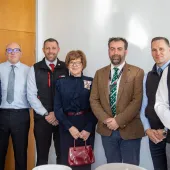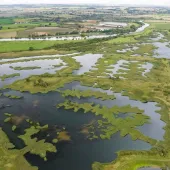NAM/RESTORE best-practice events

2014 best-practice demonstration events programme gets under way with visit to Threshfield Quarry
THE first in a series of NAM/RESTORE best-practice demonstration events for 2014 took place in North Yorkshire on 12 June.
Focusing on the merits of letting natural regeneration play its part for nature within a site’s restoration plan, the event attracted 30 stakeholders from across the minerals industry, local planning authorities, statutory agencies, conservation NGOs and environmental consultancy sectors.
They heard how and where natural regeneration has played a significant part in enhancing the biodiversity of a site, received advice on what measures can be adopted to benefit which species, and took part in an informal questions and answers session to swap details of incidences of good practice in this area.
Referencing a number of relevant case studies in the UK and within RESTORE partner countries, Nature After Minerals’ restoration adviser, Liz Harris, opened the morning session with an overview of how mineral sites can provide vital opportunities for natural habitat succession, enabling early pioneer species communities to become established in a way which is increasingly difficult in the wider landscape, where land tends to be intensively managed and farmed.
Buglife’s lead ecologist, Dr Sarah Henshall, then provided a detailed breakdown of invertebrate species which can benefit from a mixture of open-mosaic habitat creation on a site, sitting alongside areas of undisturbed and disturbed land. She recommended the monitoring of a site to establish what species are present and to retain features which support them. She explained how natural regeneration of a site can often represent the best outcomes for biodiversity, both at active and worked-out quarries.
Before embarking on a site visit to Lafarge Tarmac’s Threshfield Quarry in the afternoon, Nick Beale, Lafarge Tarmac’s estate manager, together with Roger Martlew, chair of the Threshfield Quarry Development Trust, gave an introduction to the quarry and charted its recent planning history and restoration options.
The delegates were interested to note the active recommendation and decision to make natural regeneration a key component of this site’s restoration. The development trust is also keen for the site to play an important role within the local landscape, providing an important space for communities and the local economy, through the promotion of its educational and cultural heritage potential.
Attendees on the day also welcomed the opportunity to meet other individuals with an input to decisions affecting mineral site restoration and management and to learn from each other’s experiences.
This was exemplified by one officer from a planning authority in the north of England, who commented that the event demonstrated the ‘...extremely important, imaginative and informative way of collaborating in order to achieve the desired ‘working together’ ethos to achieve the common goal – the best restoration possible for mineral sites’.
For further information on other best-practice demonstration events being run throughout July, September and October 2014, visit the RESTORE and Nature After Minerals (NAM) websites.









